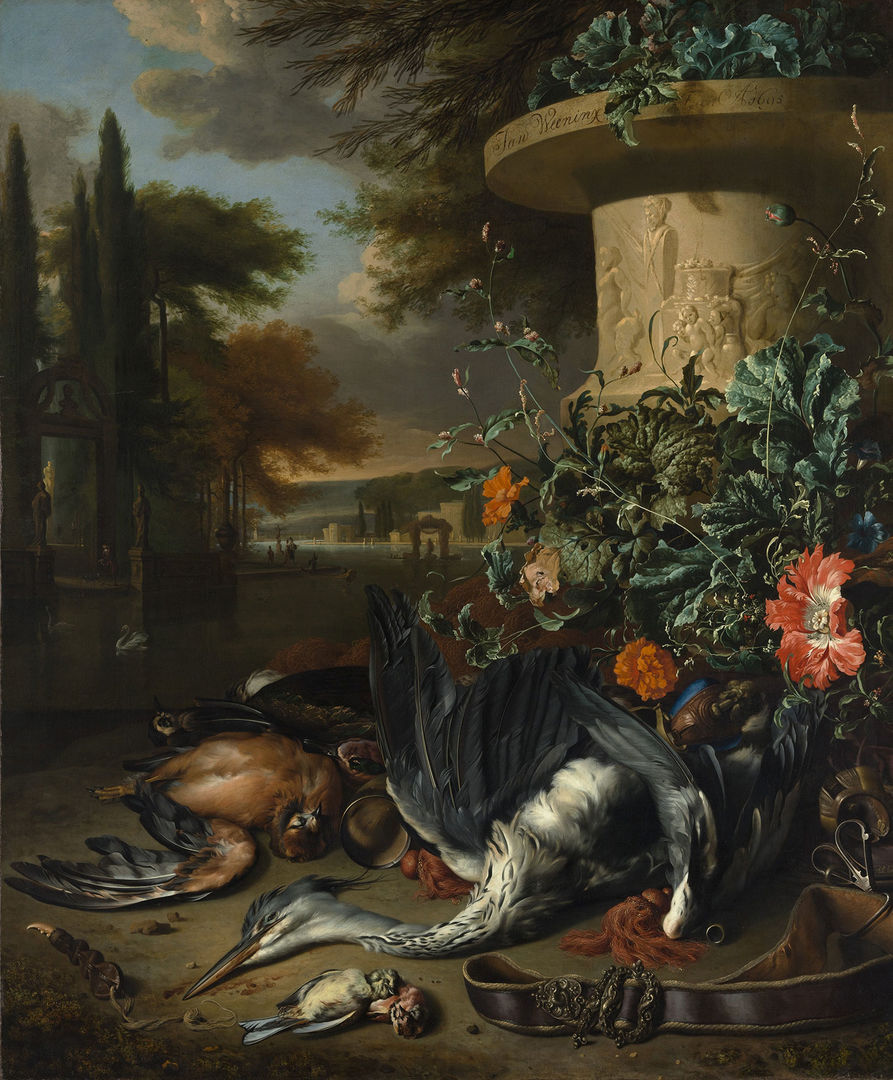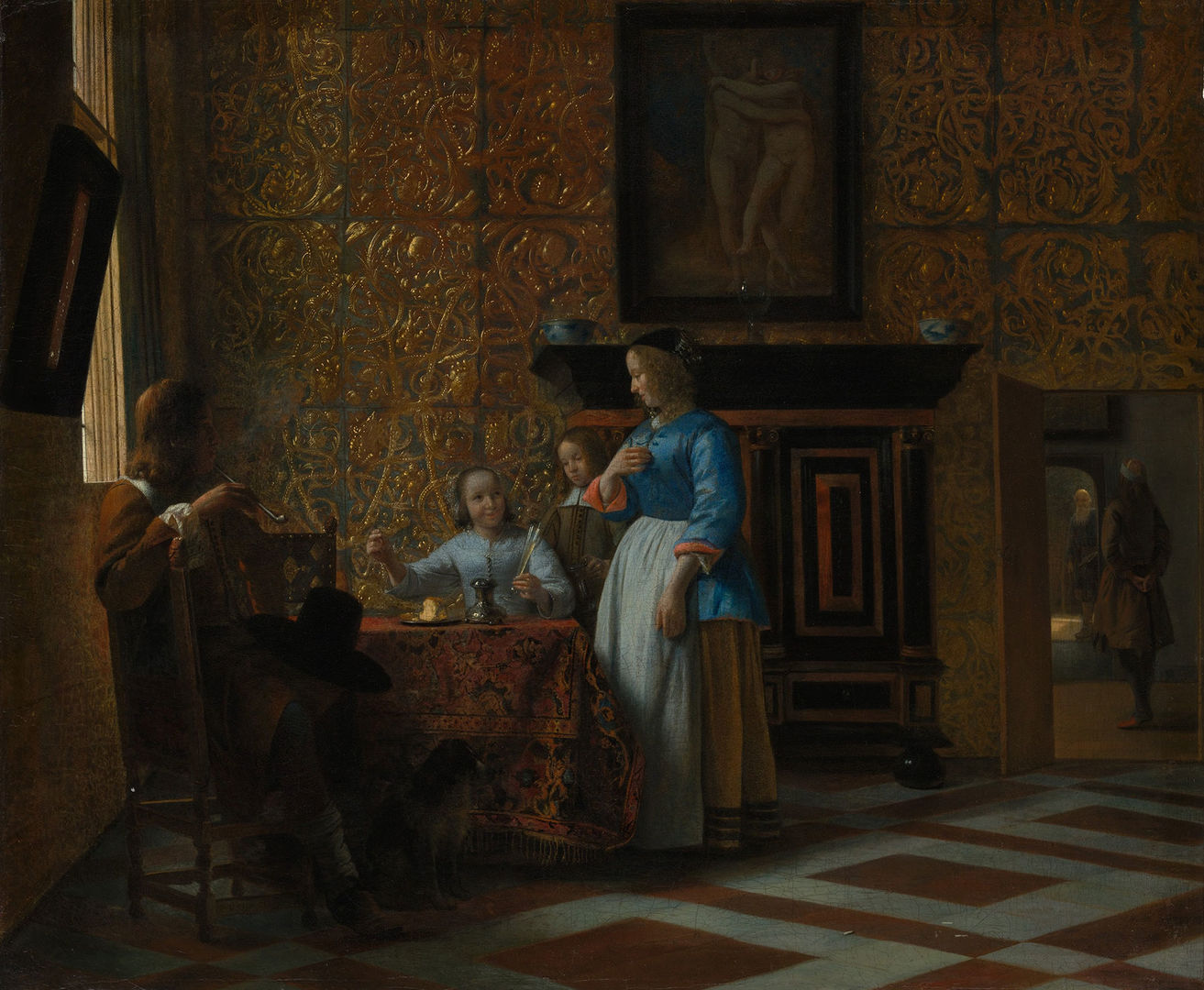Memorial
Ebony G. Patterson is an award-wining multimedia artist and painter whose work has been exhibited at numerous museums.
Listen to the Story
Audio Transcript
Ebony G. Patterson: Hi, I’m Ebony G. Patterson, and I’m an artist. I make a range of mixed-media works on paper, tapestries, installations, and video exploring ideas around beauty—beauty as a trap, codes of dress, and violence within a post-colonial space.

Jan Weenix (Dutch, ca. 1641?–1719). Gamepiece with a Dead Heron, 1695. Oil on canvas, 52 3/4 x 43 3/4 in. (134 x 111.1 cm). The Metropolitan Museum of Art, New York, Purchase, Rogers Fund, 1950 (50.55)
Narrator: Dutch masterpiece painters are not ones to shy away from life and death, themes that Patterson explores in her work, too. Take Gamepiece with Dead Heron, by Jan Weenix.
Patterson: I mean, I’m just really enthralled by the birds themselves, to be quite honest. As much as there is a morbidness that, of course, is undeniably in the foreground of the painting, it’s also incredibly beautiful. I feel like I can smell things within the painting, particularly the dead game, the animals, the birds, which also suggests how well-depicted the textures of the birds are, the textures of the flowers.
There is something slightly decorative about the painting, even though death is at its center. What I think is also really interesting is that, even though death is the first point of confrontation, there is life happening in the distance, just beyond the composed still life that’s at the front. Way in the distance, there seems to be two people, coupled. They may be going for a ride. So life is continuing in spite of the death that’s at the foreground.
I’m also interested in ways people actually use public space to memorialize people who they know or don’t know, but do that in a public way, through a public act that forces us all to all stop, pause, and acknowledge. So for example, when you go into a city, it’s not rare, for example, to see shoes thrown up on a shoe line. Often the shoes are of somebody who’s passed on, and it’s a loved one that has made a public memory, a public mark in the sky. And asking us all to stop and take note of this person who was once here and even still matters to the family or the community that he or she may have left.
I find it a little difficult, also, not to think about the colonial relationship that’s also happening pictorially. So while food is being gathered for the colony, that’s also happening through colonizing, you know? It was happening at a time when Europe was doing its grab. Africa was being split into colonies, as well as the rest of the world at the time. And bodies were being gathered and moved around.
I thought it was interesting just thinking of the word “game” as a metaphor, and what expenses happen in game. Something gets lost in order for something else to thrive, right? So there’s an exploit that happens, and this is the gathering of that exploit.
And in spite of that, the life continues in the background. The mundane activities of life continue. People, you know, are having a good time on the river while death gathers in the front. I mean, the ground is stained and the earth will hold the memory of these dead bodies, these dead birds that sit there.
It’s also about the procurement of beauty. It’s a kind of organization of beauty. And when we look at the picture, there are two points of that that are being engaged, when we’re looking at flora and fauna here. One, in the kinds of arrangement that the artist has put with the dead bodies—it almost seems like the flowers are embellishing these bodies.

Pieter de Hooch (Dutch, 1629–1684). Leisure Time in an Elegant Setting, ca. 1663–65. Oil on canvas, 21 5/8 x 26 in. (55 x 66 cm). The Metropolitan Museum of Art, New York, Purchase, Robert Lehman Collection, 1975 (1975.1.144)
Narrator: Patterson sees another layer to an otherwise pleasant interior scene. In the painting Leisure Time in an Elegant Setting, by Pieter de Hooch, death and the afterlife hover around the edges.
Patterson: I think that what’s interesting to me within the painting is actually what’s not most central in the painting. It’s an intimate space but there is also something that suggests, because of that doorway, that something else awaits and someone else awaits. And who that one is, metaphorically, we’re not quite sure.
For me, I just thought, like, the inevitable is outside the window. You know, usually doorways and windows, to me, often represent the possibility or the future outside. What’s in the doorway, what’s in the future, what’s outside waiting, actually, seems to be the end, which is presented in the embodiment of this older person. And that’s what I thought about—the older man who’s outside. He could very well be a reaper.
But I think also, too, just thinking about the clichés within which we may negotiate or think about death, right? We always think about it in terms of its ominousness, you know, and I think it’s also this weightedness. And somehow that’s associated, or thought of, in like the darker end of the scale, because it’s the not knowing. When, in fact, I mean, it’s cyclical activities of life, you know? You’re born, you live, you die.
Narrator: Patterson engages with this sense of mystery in her own artistic work, as well.
Patterson: When I start with something, I say I start with a problem and I’m trying to solve that problem. It may be, “Oh, you know, is there a way for me to reference the garden as a site of burial,” for example, “without using the figure? What other ways could I reference the figure?”
I think that as an artist my responsibility is not to illustrate, because if I’m illustrating then there’s no reason for you to think about anything. And I’m trying to get you to consider things, right? The illustration tells you what it is, while the artwork asks you what it is.
